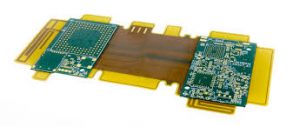How to Ensure EMI/RFI Shielding in Flexible PCB Boards
Ensure EMI/RFI Shielding in Flexible PCB Boards
EMI (Electromagnetic Interference) shielding in flexible PCB boards is a must to ensure that the circuit’s signals do not interact with unintended electromagnetic radiation. These unwanted effects can lead to malfunctioning, signal interference, and other problems with the operation of the circuit board. Fortunately, there are many EMI shielding methods and materials that can be used on flex circuits to help prevent EMI.
Basically, EMI shielding works by capturing any stray electromagnetic energy and dispersing it to other parts of the circuit. This is achieved by a special conductive layer, called an EMI shield, that connects to the ground plane of the circuit board. The ground plane is a neutralizing agent for the electromagnetic energy, so any EMI that comes into contact with it will be dispersed instead of damaging the circuit board and its components.
There are several different ways to EMI shield a flexible pcb board, with each method having its own advantages and disadvantages. The minimum bend capability and type of bending requirement also impacts the choice of shielding methods and materials. For example, a dynamic flex circuit application has much higher minimum bend capabilities than a static flex design, which requires the use of different materials and a specific shielding method.

How to Ensure EMI/RFI Shielding in Flexible PCB Boards
The most common EMI shielding solution for flex circuits is to add copper layer shields that link to the ground reference via stitched vias. These copper layers can be solid or crosshatched and enfold the signal layers. While this method offers efficient shielding, it has a negative impact on the bending capabilities of the circuit. The extra thickness of the copper shielding layers reduces the flex circuit’s bending capacity and causes mechanical stress concentration points during the bending process.
Another common method is to add a silver ink coverlay to the PCB’s main overlay. This can be applied with perforations to allow for the necessary electrical interconnections. This is an inexpensive option that only increases the PCB’s thickness by about 75%. However, it does not provide as much EMI attenuation as the other options.
The best way to ensure EMI/RFI shielding in your flex circuit is to work with a trusted and experienced PCB fabricator that specializes in flex circuits. They will be able to offer the right recommendations on which EMI shielding material to choose and will be able to advise you on the best manufacturing techniques for your flex circuits.
Altium Designer, the industry’s premier PCB layout software, provides an advanced EMI shielding capability that works seamlessly with your design. With full support for SolidWorks, PTC Creo, Autodesk Inventor and Fusion 360, you can use Altium Designer to collaborate with your mechanical and electrical teams to ensure that your flex circuit is designed for both EMI/RFI shielding and the required bending characteristics. To get started, contact the Altium team today.